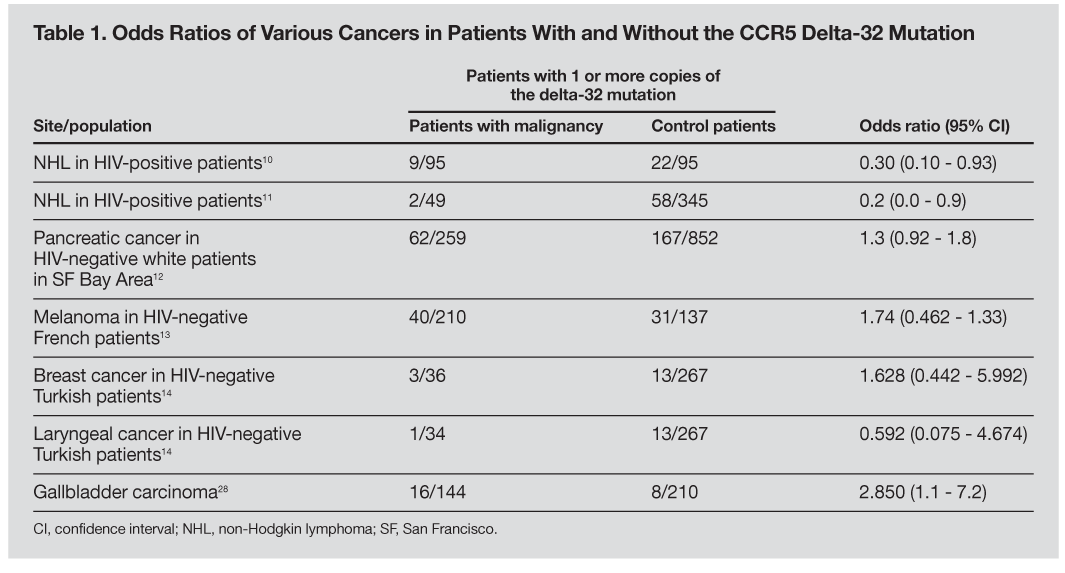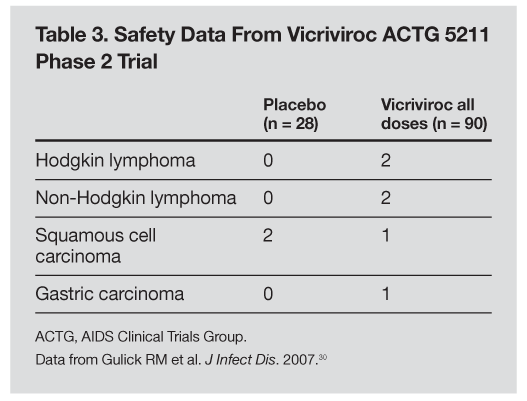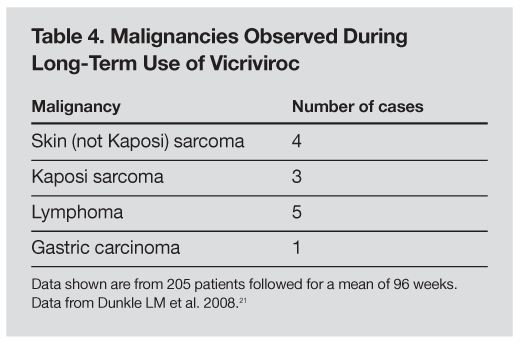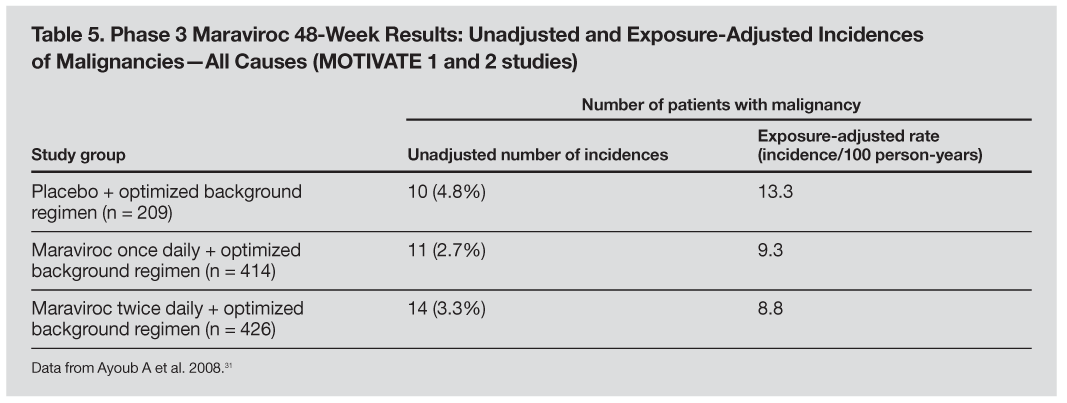CCR5 Antagonists in the Treatment of HIV-Infected Persons: Is Their Cancer Risk Increased, Decreased, or Unchanged?
With the FDA approval of a new small-molecule drug to treat HIV infection by blocking the CCR5 chemokine receptor and with several other drugs of this class in development for this and other indications, there is an increased interest in determining the potential influence on tumor promotion or suppression that blocking this receptor may have. Large, long-term clinical studies would be the ideal method for evaluating the potential increase in cancer risk, and at least one such study is under way (see http://clinicaltrials.gov/show/NCT00665561?order=49).
With the FDA approval of a new small-molecule drug to treat HIV infection by blocking the CCR5 chemokine receptor and with several other drugs of this class in development for this and other indications, there is an increased interest in determining the potential influence on tumor promotion or suppression that blocking this receptor may have. Large, long-term clinical studies would be the ideal method for evaluating the potential increase in cancer risk, and at least one such study is under way (see http://clinicaltrials.gov/show/NCT00665561?order=49).
In the meantime, the results of several registrational trials of these agents are in the public domain, although these data are shorter-term and may not reflect the true risk of increased malignancy given the protracted course of neoplastic development. Furthermore, many large epidemiological surveys of cancer rates in persons with the naturally occurring mutation of CCR5 delta-32, which results in the expression of nonfunctioning receptors, exist. This knowledge, combined with our understanding of the role of CCR5 in oncogenesis and tumor promotion, can provide some indication of the expected influence on cancer risk that the use of CCR5 antagonists may have.
OVERVIEW OF THE CHEMOKINE SYSTEM
Chemokines are chemical messengers, proteins secreted by immune cells that orchestrate immune responses. Chemokines bind to chemokine receptors on the surface of immune cells to effect this orchestration. Other proteins, like chemokines, that bind to receptors are referred to as the ligands of receptors. While more than 600 chemokine receptor proteins have been identified, only 18 have been cloned. These have been characterized as 2 major (CCR and CXCR) and 2 minor (CX3CR and XCR) groups. Receptors in each group only bind one group of chemokines, but the same chemokines may bind multiple receptors in the same group. For example, there have been 4 naturally occurring ligands that exhibit specificity to CCR5 identified thus far: MIP-1α, MIP-1β, MCP-1, and RANTES. However, RANTES also binds to CCR1 and CCR3 but does not bind to any of the receptors from the CXCR, CX3CR, or XCR group. Interactions between this network of chemokines and their receptors orchestrate the immune response.1
One of the best-understood chemokine receptors is CCR3. The CCR3 receptor is expressed primarily on eosinophils and appears to be responsible for their migration; blocking this receptor inhibits chemotaxis in vitro. Eotaxin, a ligand for the CCR3 receptor, seems to be overexpressed in patients with asthma, a disease characterized by eosinophilic hyperactivity.2 While the chemokine system regulates normal immune function and response to pathogens, it has also been exploited by various pathogens. The CCR5, CXCR4, and to a lesser extent the CCR3 receptors are utilized in conjunction with the CD4 cell surface receptor by HIV for entry into host T cells. While the exact function of CCR5 is somewhat less well understood, CCR5 seems to function in lymphocyte trafficking like other chemokine receptors. Natural killer (NK) cells and antigen-specific T cells when presented with foreign antigens secrete CCR5 ligands, such as RANTES, into the surrounding extracellular matrix. These ligands attract CCR5-positive cells, such as mature T cells, NK cells, and monocytes, to areas of infection and contribute to an immune and inflammatory response.3
ROLE OF THE CCR5 SYSTEM IN CANCER
Many studies have tried to elucidate the role of chemokines and their receptors in cancer. Indeed, many chemokines were first isolated from the supernatants of cell cultures of tumors. The fact that many chemokines were identified in this manner might, at first glance, make one think that each chemokine and its receptor is involved, if not in the induction of cancer, then in the progression of, angiogenesis in, and production of extracellular stroma for tumors. Not surprisingly, the picture is vastly more complicated. The same chemokine may have completely different effects on different types of malignant cells. The same chemokine that promotes growth in one tumor type may block growth in another and may do so by different mechanisms.
RANTES, the primary ligand of CCR5, has been shown to be overexpressed in breast cancer,4 and breast cancer cell lines have been shown to migrate toward RANTES.5 A study of CCR5 expression in a large sample of various subtypes of T-cell non-Hodgkin lymphomas (NHLs) shows the complex associations between the various lymphoma subtypes and expression of various chemokine receptors.6 Consistent expression of CCR5 was shown only in a small subset of NHLs, ie, anaplastic lymphoma kinase–positive anaplastic large-cell lymphoma. In a detailed analysis of 141 patients with T-cell–associated NHLs, CXCR3 expression was typical of smaller T–cell lymphomas (eg, angioimmunoblastic lymphoma) and CCR4 expression was typical of other lymphoma types. CCR5 expression was not consistently seen in any lymphoma types. Another preclinical study of the CCR5 antagonist TAK-779 showed that TAK-779 blocked RANTES-induced cell invasion and proliferation of prostate cancer cells in cell culture.7
EPIDEMIOLOGICAL STUDIES OF PERSONS WITH THE CCR5 DELTA-32 MUTATION
The delta-32 mutation of the CCR5 receptor gene is present in up to 20% of the white population worldwide.8 Persons who have 2 copies of this mutant gene have been shown to be highly resistant to HIV infection; those with a single copy can be infected but experience an attenuated course of disease.9 There have been many epidemiological studies that have compared the prevalence of the delta-32 mutation in persons with certain cancers with its prevalence in similar, nondiseased populations (Table 1). One particularly well-studied malignancy is NHL in HIV-positive persons. There are 2 retrospective studies that show a significantly reduced risk of NHL in persons with HIV/AIDS who have the CCR5 delta-32 mutation.10,11 The research by Dean and colleagues10 also examined RANTES in B-cell culture and found that it has a significant proliferative effect. This suggests that the role of the delta-32 mutation in NHL may be more than just ameliorating the effects of HIV infection; the presence of the mutant CCR5 may also attenuate chemokine-mediated B-cell proliferation in NHL.

In addition to these retrospective studies in HIV-positive persons with NHL, there are several studies of similar design that are looking at the prevalence of the delta-32 mutation in HIV-negative persons with various other malignancies and in matched controls. One study of HIV-negative patients with pancreatic cancer in San Francisco showed that the presence of the delta-32 mutation was not significantly different in those patients compared with a group of matched controls.12 A French study also failed to show any significant increase of the delta-32 mutation in patients with melanoma.13 A similarly designed study looked at Turkish patients with a variety of malignancies: breast, laryngeal, thyroid, and brain.14 In this study, although a trend toward greater prevalence of delta-32 mutation in breast carcinoma patients was noted, the association did not reach statistical significance. Although an opposite trend in laryngeal cancer patients was noted, the results were also not statistically significant. Of the 30 thyroid and 20 brain cancer patients in the Turkish study, no delta-32 mutations were identified, although the frequency of the allele (2.2%) was low in the general Turkish population that served as controls.
In addition to these retrospective analyses, there is one prospective study of patients with alcoholic cirrhosis and the likelihood of their developing hepatocellular carcinoma (HCC) or dying based on the presence of the delta-32 mutation.15 By the end of the study (mean follow-up of 62.9 months), HCC had developed in 12 of the 36 patients (33%) who had had at least 1 copy of the delta-32 mutation and 50% had died, compared with 35% and 34%, respectively, of those in the wild-type CCR5 homozygote group-again, not a statistically significant difference.
These studies of the prevalence of genetic mutations of CCR5 ligands in certain malignancies serve to further elucidate the potential role of CCR5 antagonism in cancer risk.9-13 Arguably, though they may not replicate completely the effects of blocking CCR5, because while it is tempting to assume that a mutated version of a CCR5 ligand is unable to bind CCR5 and accordingly unable to elicit the effects of the wild-type ligand, it is possible that mutant ligands might bind receptors more avidly and may therefore either block or agonize CCR5. In the San Francisco study of pancreatic cancer, the investigators looked at RANTES mutations as well as the CCR5 delta-32 mutation.12 The odds ratio of pancreatic cancer in patients with 1 mutant copy of the RANTES gene was shown to be 0.99; in patients homozygous for the RANTES mutation, the odds ratio was 0.82-not a statistically significant difference.
These epidemiological studies all examine the association of mutant CCR5 or mutated CCR5 ligands and their association with the risk of developing cancers.9-13 Another approach in evaluating the role of CCR5 in cancer is to study patients with established disease and see how the presence of mutated CCR5 affects disease progression. A Spanish study of cancer patients showed that the allelic frequency of delta-32 was no different in a cohort of 547 women with breast cancer than in the general population.16 The effect of the delta-32 mutation on disease-free survival was more complex. In patients whose breast cancer had the p53 mutation (p53 is a tumor-suppressor gene that is often mutated in a variety of cancers), the delta-32 was associated with a shortened disease-free survival. However, in those patients without the p53 mutation, the delta-32 had no effect on survival.
CANCER RISK IN HIV-INFECTED PATIENTS
Persons with HIV/AIDS have a much higher rate of various malignancies than the general population. One retrospective analysis of 375,933 persons with HIV infection over 22 years showed that in HIV-infected persons, the incidence of a variety of malignancies was significantly higher (Table 2). In this study, standardized incidence ratios were used to compare the incidences of malignancies in HIV-infected persons with the expected incidences of malignancies in the general population. The study included all malignancies, not just the CDC AIDS-defining malignancies, ie, Kaposi sarcoma, NHL, and cervical cancer.

While these data provide compelling evidence that HIV-infected persons are at increased risk for malignancies, they do not estimate the expected incidence of malignancy over a defined period. Other studies explore the incidence rates of various malignancies in HIV-infected patients. One study shows that the incidence of NHL in HIV-positive patients ranged from 42.9 per 10,000 patient-years to 86.0 per 10,000 patient-years.17 The higher incidence was observed for years 1993 and 1994 and the lower incidence for years 1997 and 1998. Because highly active antiretroviral therapy was not available until the later period, the reduction between the two periods is likely explained by the use of highly active antiretroviral therapy and subsequent lower viral loads and higher CD4 counts. Furthermore, the publication of the results from the Strategies for Management of Antiretroviral Therapy (SMART) study reinforces the idea that HIV-infected patients are at increased risk for malignancies not typically associated with HIV infection, especially those patients who are not receiving therapy, suggesting that a lower CD4 count and higher viral load may be causative factors for cancer development in persons infected with HIV.18
CANCER RISK IN CLINICAL TRIALS OF CCR5 ANTAGONISTS
In 2006 when 5 malignancies were observed in the treatment group in an interim analysis of the AIDS Clinical Trials Group (ACTG) 5211 study, which was a phase 2 trial of vicriviroc in treatment-experienced patients, concerns that vicriviroc had a causative role in these cases were raised.19

Three CCR5 coreceptor antagonists have reached phase 2 or 3 testing, one of which is now approved. GlaxoSmithKline decided not to move forward with their compound aplaviroc because of elevated transaminase levels seen in an interim analysis in a phase 2 trial. Pfizer and Schering-Plough have moved forward with their compounds, maraviroc and vicriviroc, respectively, and maraviroc is now approved. There are currently data from two phase 2 trials of vicriviroc in treatment-experienced patients. At 48 weeks in the ACTG 5211 trial, 6 malignancies in the vicriviroc treatment arms and 2 in the control group were ultimately observed (Table 3). Malignancies observed in the second vicriviroc trial, the Vicriviroc (SCH 417690) in Combination Treatment With Optimized ART Regimen in Experienced Subjects (VICTOR-E1) study, were not delineated in the primary study presentation.20 However, in a pooled analysis of adverse events in patients randomized to receive vicriviroc in the ACTG 5211 and VICTOR-E1 studies and of adverse events in patients rolled over (from the placebo and vicriviroc arms) to receive open-label vicriviroc at the end of the 48-week study periods, 13 malignancies among 205 patients who received vicriviroc were recorded (Table 4).21 The mean duration of vicriviroc therapy in these 205 patients was 96 weeks (range, 1 to 216 weeks), and 196 received vicriviroc for more than 12 weeks. While there was no placebo group comparison, the incidence rate of malignancies remained nearly constant over time rather than increasing as the cumulative exposure to vicriviroc increased, suggesting that vicriviroc exposure likely does not increase the already elevated risk of malignancy in this study population.

The Epstein-Barr virus (EBV) has been implicated in the pathogenesis of Hodgkin lymphoma and Burkitt lymphoma in HIV-infected persons.22 A recent study sought to discover whether vicriviroc may have a role in increasing EBV replication in these persons,23 thereby giving a mechanistic explanation for the potential role that vicriviroc may have played in the lymphoma occurrences in patients in ACTG 5211 trial. The study showed that there was no increased replication of EBV in the 116 subjects for whom samples existed after vicriviroc administration. There is no statistical evidence suggesting an association between vicriviroc administration and development of lymphoma, and this study also disproves a potential mechanism.
Two phase 3 trials of maraviroc in treatment-experienced patients have been conducted. Both trials had identical designs but were conducted in different geographical locations. The data from both trials were combined, analyzed, and published in 2008.24 This publication did not report the rates of non–AIDS-defining malignancies observed in the study groups.
These incidence data are somewhat difficult to interpret. None of these trials were sufficiently powered to ascribe causality given the low incidence of malignancies observed. Another difficulty in interpreting differences in cancer incidence between the treatment arms of CCR5 antagonist trials and the placebo groups is that all of the studies had many more patients in the treatment arms than in the control arms, and patients in the placebo arms were more likely to discontinue treatment early for virological failure. As a result, instead of absolute numbers, the percentage of patients in whom a malignancy develops while they are receiving therapy might correct for the smaller size of the placebo groups, and exposure-adjusted analysis might correct for the shorter duration of follow-up in the patients who received a placebo.
Adverse event data from the maraviroc phase 2 trial in treatment-experienced patients were recently reanalyzed and exposure-adjusted. Both unadjusted and exposure-adjusted rates of malignancies were higher in the placebo group than in either dose group of maraviroc at 48 weeks (Table 5). The 96-week data from this trial were recently presented and showed similar results. The unadjusted rates of malignancies were 5.3%, 4.3%, and 4.5% in the placebo, maraviroc once-daily, and maraviroc twice-daily arms, respectively.25

While there were 3 times as many malignancies in the vicriviroc arms of the ACTG 5211 study than in the placebo group, there were also more than 3 times as many patients in the vicriviroc arms. The maraviroc phase 3 data show that cancer incidence rates were actually higher in the placebo group, which may have to do with the fact that lower rates of virological suppression and lower CD4 counts were observed in the placebo group and more advanced disease is associated with higher cancer risk in HIV-infected persons.
Finally, there are 2 studies of CCR5 antagonists in treatment-naive patients. The 48-week data from a study of maraviroc in treatment-naive patients showed that there was both a higher absolute number and percentage of malignancies observed in the comparator group: 16 (4.4%) versus 10 (2.8%) in the efavirenz and maraviroc arms, respectively.26 The published report of the 48-week data from another study of vicriviroc in treatment-naive patients states that one case of exacerbation of preexisting Kaposi sarcoma was seen in the placebo group, but the report does not mention any other malignancies.27
CONCLUSION
This article examines 3 sources of data regarding the cancer risk with the use of CCR5 antagonists in HIV-infected patients: basic science research concerning the role of CCR5 in cancer pathogenesis, epidemiological studies of cancer rates in patients with congenital lack of functional CCR5, and clinical data of cancer rates in CCR5 antagonist studies. Available preclinical evidence suggests that CCR5 is critical to the development and progression of certain tumors and that, at least theoretically, blocking CCR5 seems unlikely to increase cancer risk. Epidemiological data in non–HIV-infected persons do not show a significantly different rate of the delta-32 mutation in persons with several different malignancies compared with matched controls without malignancies. In fact, persons with HIV infection and the delta-32 mutation appear to have a decreased risk of NHL.
Finally, while the available clinical data from trials of CCR5 antagonists show that malignancies have developed in patients in the treatment arms, they do not demonstrate a cancer risk that is significantly different from that in patients in the control groups. Given that development of malignancies is typically a long-term process, and only 2 of the studies of CCR5 antagonists have published data extending beyond 48 weeks, long-term studies are needed to more definitively establish whether CCR5 antagonism reduces, increases, or has no effect on cancer risk.
Dr McNiff is an employee of Pfizer, the manufacturer of the CCR5 antagonist maraviroc (Selzentry). No potential conflict of interest relevant to this article was reported by Dr Dezube.
References:
References1. Horuk R. Chemokine receptors. Cytokine Growth Factor Rev. 2001;12:313-335.
2. Ying S, Robinson DS, Meng Q, et al. Enhanced expression of eotaxin and CCR3 mRNA and protein in atopic asthma. Association with airway hyperresponsiveness and predominant co-localization of eotaxin mRNA to bronchial epithelial and endothelial cells. Eur J Immunol. 1997;27:3507-3516.
3. Lederman MM, Penn-Nicholson A, Cho M, Mosier D. Biology of CCR5 and its role in HIV infection and treatment. JAMA. 2006;296:815-826.
4. Azenshtein E, Luboshits G, Shina S, et al. The CC chemokine RANTES in breast carcinoma progression: regulation of expression and potential mechanisms of promalignant activity. Cancer Res. 2002;62:1093-1102.
5. Youngs SJ, Ali SA, Taub DD, Rees RC. Chemokines induce migrational responses in human breast carcinoma cell lines. Int J Cancer. 1997;71:257-266.
6. Jones D, O'Hara C, Kraus MD, et al. Expression pattern of T-cell-associated chemokine receptors and their chemokines correlates with specific subtypes of T-cell non-Hodgkin lymphoma. Blood. 2000;96:685-690.
7. Vaday GG, Peehl DM, Kadam PA, Lawrence DM. Expression of CCL5 (RANTES) and CCR5 in prostate cancer. Prostate. 2006;66:124-134.
8. Martinson JJ, Chapman NH, Rees DC, et al. Global distribution of the CCR5 gene 32-basepair deletion. Nat Genet. 1997;16:100-103.
9. Huang Y, Paxton WA, Wolinsky SM, et al. The role of a mutant CCR5 allele in HIV-1 transmission and disease progression. Nat Med. 1996;2:1240-1243.
10. Dean M, Jacobson LP, McFarlane G, et al. Reduced risk of AIDS lymphoma in individuals heterozygous for the CCR5-delta32 mutation. Cancer Res. 1999;59:3561-3564.
11. Rabkin CS, Yang Q, Goedert JJ, et al. Chemokine and chemokine receptor gene variants and risk of non-Hodgkin's lymphoma in human immunodeficiency virus-1-infected individuals. Blood. 1999;93:1838-1842.
12. Duell EJ, Casella DP, Burk RD, et al. Inflammation, genetic polymorphisms in proinflammatory genes TNF-A, RANTES, and CCR5, and risk of pancreatic adenocarcinoma. Cancer Epidemiol Biomarkers Prev. 2006;15:726-731.
13. Rodero M, Rodero P, Descamps V, et al. Melanoma susceptibility and progression: association study between polymorphisms of the chemokine (CCL2) and chemokine receptors (CX3CR1, CCR5). J Dermatol Sci. 2007;46:72-76.
14. Degerli N, Yilmaz E, Bardakci F. The delta32 allele distribution of the CCR5 gene and its relationship with certain cancers in a Turkish population. Clin Biochem. 2005;38:248-252.
15. Nahon P, Sutton A, Rufat P, et al. Lack of association of some chemokine system polymorphisms with the risks of death and hepatocellular carcinoma occurrence in patients with alcoholic cirrhosis: a prospective study. Eur J Gastroenterol Hepatol. 2007;19:425-431.
16. Mañes S, Mira E, Colomer R, et al. CCR5 expression influences the progression of human breast cancer in a p53-dependent manner. J Exp Med. 2003;198:1381-1389.
17. Besson C, Goubar A, Gabarre J, et al. Changes in AIDS-related lymphoma since the era of highly active antiretroviral therapy. Blood. 2001;98:2339-2344.
18. Strategies for Management of Antiretroviral Therapy (SMART) Study Group. CD4+ count-guided interruption of antiretroviral treatment. N Engl J Med. 2006;355:2283-2296.
19. Schering-Plough. Vicriviroc demonstrates potent and sustained viral suppression in ACTG phase II clinical study in treatment-experienced HIV patients [press release]. Toronto; PRNewswire; August 17, 2006.
20. Zingman B, Suleiman J, DeJesus E, et al. Vicriviroc in combination therapy with an optimized ART regimen for treatment-experienced subjects: VICTOR-E1. 15th Conference on Retroviruses and Opportunistic Infections; February 3-6, 2008; Boston. Abstract 795.
21. Dunkle LM, Greaves WL, McCarthy MC, et al. Long-term safety of vicriviroc. 48th Annual Interscience Conference on Antimicrobial Agents and Chemotherapy (ICAAC)/Infectious Diseases Society of America (IDSA) 46th Annual Meeting; October 25-28, 2008; Washington, DC. Abstract H-1269.
22. Grogg KL, Miller RF, Dogan A. HIV infection and lymphoma. J Clin Pathol. 2007;60:1365-1372.
23. Tsibris AM, Paredes R, Chadburn A, et al. Lymphoma diagnosis and plasma Epstein-Barr virus load during vicriviroc therapy: results of the AIDS Clinical Trials Group A5211. Clin Infect Dis. 2009;48:642-649.
24. Gulick RM, Lalezari J, Goodrich J, et al; MOTIVATE Study Teams. Maraviroc for previously treated patients with R5 HIV-1 infection. N Engl J Med. 2008;359:1429-1441.
25. Hardy WD, Gulick R, Mayer HB, et al. Efficacy and safety of maraviroc in treatment-experienced (TE) patients infected with R5 HIV-1: 96-week combined analysis of the MOTIVATE 1 and 2 studies. 9th International Congress on Drug Therapy in HIV Infection; November 9-13, 2008; Glasgow, Scotland. Abstract 0425.
26. Saag M, Ive P, Heera J, et al. A multicenter, randomized, double-blind, comparative trial of a novel CCR5 antagonist, maraviroc versus efavirenz, both in combination with Combivir (zidovudine [ZDV]/lamivudine [3TC]), for the treatment of antiretroviral naive patients infected with R5 HIV-1: week 48 results of the MERIT study. 4th International AIDS Society Conference on HIV Treatment and Pathogenesis; July 22-25, 2007; Sydney, Australia. Abstract WESS104.
27. Landovitz RJ, Angel JB, Hoffmann C, et al. Phase II study of vicriviroc versus efavirenz (both with zidovudine/lamivudine) in treatment-naive subjects with HIV-1 infection. J Infect Dis. 2008;198:1113-1122.
28. Srivastava A, Pandey SN, Choudhuri G, Mittal B. CCR5 Delta32 polymorphism: associated with gallbladder cancer susceptibility. Scand J Immunol. 2008;67:516-522.
29. Engels EA, Pfeiffer RM, Goedert JJ, et al; for the HIV/AIDS Cancer Match Study. Trends in cancer risk among people with AIDS in the United States 1980-2002. AIDS. 2006;20:1645-1654.
30. Gulick RM, Su Z, Flexner C, et al; AIDS Clinical Trials Group 5211 Team. Phase 2 study of the safety and efficacy of vicriviroc, a CCR5 inhibitor, in HIV-1-infected, treatment-experienced patients: AIDS clinical trials group 5211 Team. J Infect Dis. 2007;196:304-312.
31. Ayoub A, Goodrich J, van der Ryst E, et al. Adverse event profile of maraviroc in treatment-experienced patients infected with R5 HIV-1. 48th Annual Interscience Conference on Antimicrobial Agents and Chemotherapy (ICAAC)/Infectious Diseases Society of America (IDSA) 46th Annual Meeting; October 25-28, 2008; Washington, DC. Poster H-1264.